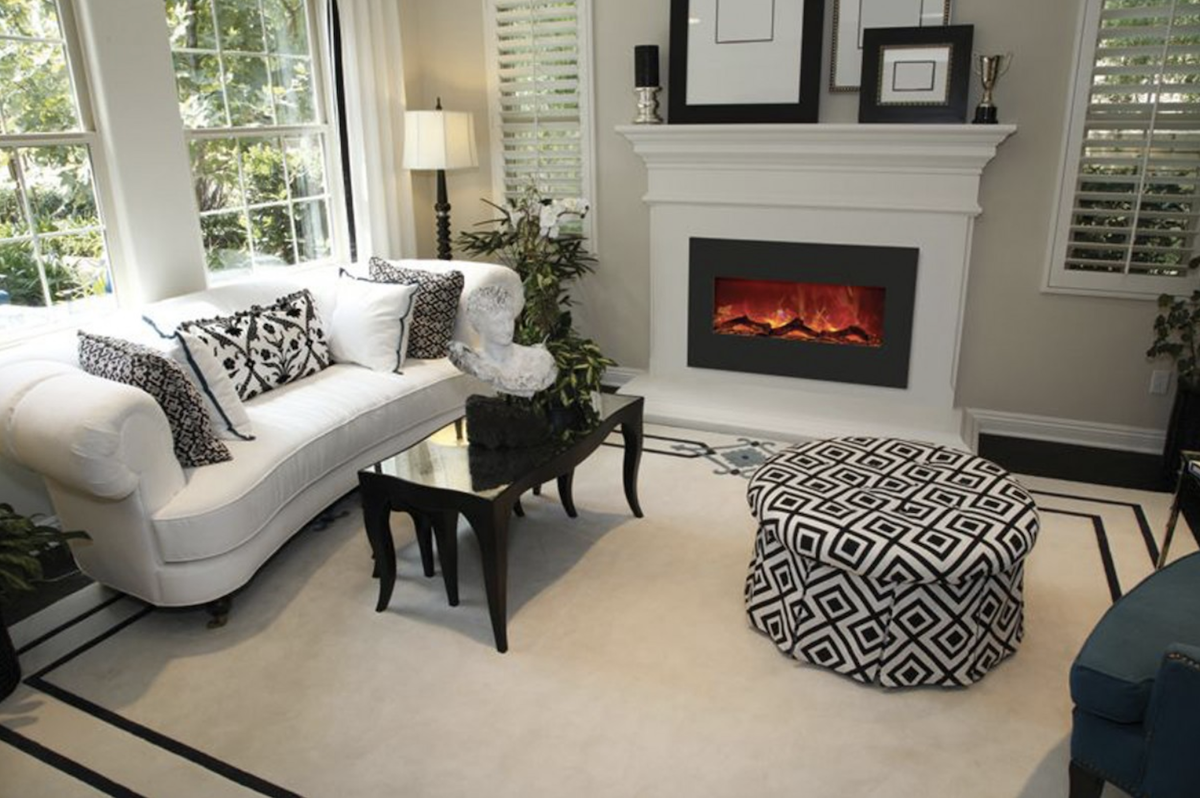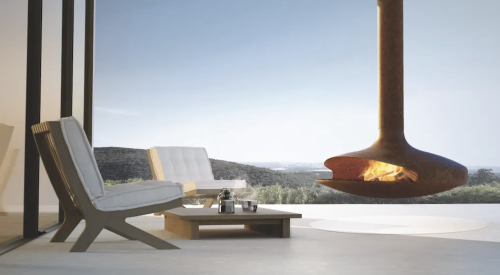In today's tough market, it's smart to take advantage of any opportunity to gain an edge over your competition. One way to do this may be right under your nose: the fireplaces in your homes. A cozy, inviting fire has always been a place to gather, reconnect and get away from the pressures of everyday life. As the weather grows colder and the price of fuel increases, now is a perfect time to talk to home buyers about the advantages of a fireplace. To do so effectively, it's essential to ensure your construction teams understand the fundamentals and best practices related to today's fireplaces.
In production home building, there are three main types of fireplaces: direct-vent gas fireplaces, B-vent gas fireplaces and electric fireplaces. No matter the type, they naturally add to the aesthetics and comfort of any room. Nowadays, certain fireplaces can also play a role in a home's energy efficiency and indoor air quality, two areas that have received increasing attention in recent years. By choosing the right types of fireplaces and installing them correctly, housing giants can capitalize on the multiple benefits this home feature offers.
Fireplace Popularity
The popularity of fireplaces continues to hold true. In 2007, the National Association of Realtors surveyed home buyers across the U.S. to determine what today's buyer looks for in a home. In the association's report, “Profile of Buyers' Home Feature Preferences,” the NAR showed that at 46 percent — nearly half of buyers — said they would spend more for a home if it had a fireplace. Surprisingly, the data also showed that the number of buyers who listed fireplaces as a “very important” or “important” feature was evenly distributed across the U.S. rather than depend on the geographic area; buyers in the South, Northeast, Midwest, and West gave fireplaces equal importance.
Comfort
Comfort plays a large role in the happiness of a home's occupants. As a supplementary source of heating, fireplaces can help keep the living space warm during cold months. Tim Rethlake, vice president of new construction sales at Hearth & Home Technologies, recommends that builders discuss a concept called “zone heating” with customers. “Zone heating with a fireplace is a big selling point that a builder's sales staff should be making with customers. A fireplace allows homeowners to heat the rooms they spend the most time in, while allowing them to turn down the thermostat on the central heating system. Why heat the whole home when you're not using the whole home?” Rethlake makes a good point: explaining zone heating to customers allows sales staff to not only touch upon the topic of comfort, but also the topic of energy efficiency.
Drafts are the most common callback home builders experience with fireplaces, and they have a direct impact on occupant comfort. For homeowners, there's little that's more annoying then relaxing before a cheery fire with cold drafts moving through the space, causing both the room's air and floors to feel uncomfortable. After a home is built, drafts are one of the most complex issues to solve, so it's best to be proactive about preventing mistakes from occurring during construction.
The major cause of drafts is improperly insulating, draftstopping and air sealing a fireplace that's located on an exterior wall. Fireplaces are poorly insulated typically because an installer didn't insulate the framing behind the fireplace, leaving it outside the home's thermal enclosure. They have poor draftstopping and air sealing because these details are frequently forgotten, missed or installed incorrectly.
To minimize the likelihood of drafts, it's important to educate construction teams on the best practices. Insulation should be installed in all wall cavities between the fireplace unit and the outdoors. After the insulation is installed, a continuous rigid air barrier of wood sheathing, drywall, or Thermo-ply should be installed along the inside of all exterior walls around the fireplace. Finally, all corners, edges and seams should be thoroughly sealed with foam.
Fireplaces and Energy Efficiency
Beyond aesthetics and comfort, certain fireplaces can also offer energy efficiency. Due to the rising cost of fuel, consumers are searching for more energy-efficient ways to heat their home and have turned to fireplaces as one solution. The NAR's 2007 survey asked participants about the importance of energy efficiency and found that 46 percent of all buyers listed an energy-efficient home as “very important” to them, and a whopping 92 percent said an energy-efficient home was at least “somewhat important” to them. These numbers reflect the current trend of consumers increasingly looking for ways to reduce their utility bills.
Adam Martin, CFO of Martin Sales and Service, a fireplace company in Pittsburgh, Pa., has seen this trend in action. “We've seen about a 20 percent increase in our fireplace sales, especially over the past year. Today's customers are driven by the need to save on rising fuel costs, to find a more energy-efficient way of heating their home. In the past, their No. 1 reason for purchasing a fireplace was for the pleasing aesthetics, but now our customers are looking to reduce their energy bills. Aesthetics have fallen to the No. 2 spot.” Of the different types of fireplaces available on the market, direct-vent gas fireplaces are the most energy efficient, and indeed, these fireplaces have been the most popular at Martin Sales and Service for new home construction.
PRO TIP
One way to minimize the risk of backdrafting with a B-vent gas fireplace is to attach a combustion air duct to the fireplace unit and route it through the exterior wall. Combustion air ducts bring outdoor air directly to the firebox to satisfy the need for combustion air.
While consumers may see energy efficiency as important, they may not know exactly how a fireplace helps. At Martin Sales and Service, they discuss zone heating and its role in energy efficiency with their customers. Says Martin: “We explain to customers that zone heating with a fireplace allows them to keep the living areas warmer, while the rest of the home stays cooler. As a result, the amount of energy the whole home uses is decreased.” In addition to zone heating, here are a few other ways to increase energy efficiency:
- Choose sealed combustion, direct-vent gas fireplaces. These fireplaces eliminate air loss up the chimney and offer flexible installation options with horizontal venting.
- Install high-efficiency gas fireplaces. The higher the AFUE rating, the more efficient the fireplace.
- Opt for fireplaces with an electronic ignition. Fireplaces with a standing pilot light waste gas when the fireplace isn't in use.
- Choose fireplaces with a ceramic-molded refractory or liner. This feature helps radiate more heat into the room.
- Select fireplaces with a variable flame feature. This feature controls the flame height based on the room's temperature, helping homeowners conserve energy.
The Importance of Indoor Air Quality
The best types of fireplaces to install are those that don't impact indoor air quality. The two fireplaces that fall into this category are electric fireplaces and direct-vent gas fireplaces. Electric fireplaces don't affect indoor air quality because their power source is electricity, which produces zero emissions. Direct-vent gas fireplaces don't affect indoor air quality because they have a sealed combustion vent system. With this system, combustion air is drawn from the outdoors into a sealed firebox, and combustion gases are exhausted back to the outdoors.
Other types of fireplaces have a negative impact on indoor air quality. Wood burning fireplaces with an open hearth produce wood smoke, which contains a mixture of gases and fine particles that can affect occupant health. Vent-free (or unvented) gas fireplaces also come with indoor air quality concerns. National green programs, such as Energy Star, will actually disqualify a home from receiving green certification if it has a vent-free gas fireplace.
B-vent gas fireplaces are designed to not impact indoor air quality; however, these fireplaces are at risk for backdrafting. Backdrafting occurs when another appliance, such as a bathroom or kitchen ventilation fan, is pulling air from the home at the same time as the fireplace, creating a negative pressure indoors that draws exhaust air back into the home, typically carrying combustion gases with it. The best way to minimize the possibility of this occurring is to install a combustion air duct or to replace the B-vent flue with a triple-wall flue.
Best Practices Lead to Satisfied Customers
Choosing the right types of fireplaces and installing them using industry best practices will help ensure the peace of mind and well-being of your customers.
Michael Dickens is the CEO of BuildIQ, which provides online information, tools and training in home building best practices to help builders take their homes and businesses to the next level of quality and performance.












